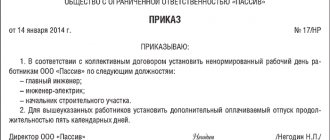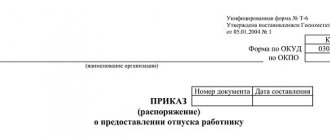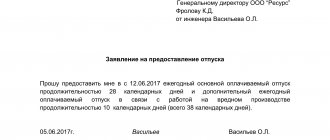When establishing the amount of additional leave for an employee for work in harmful and dangerous working conditions, the employer can use the regulatory legal acts of the USSR to the extent that does not contradict the Labor Code (clarification of the Ministry of Labor of the Russian Federation dated February 13, 2013, based on the decision of the Supreme Court of the Russian Federation dated January 14, 2013 No. AKPI12-1570, hereinafter – Decision):
- lists of productions, approved. by resolution of the State Committee for Labor of the USSR, the Presidium of the All-Union Central Council of Trade Unions dated October 25, 1974 No. 298/P-22 (hereinafter referred to as the List);
- instructions, approved Resolution of the State Committee for Labor of the USSR, the Presidium of the All-Union Central Council of Trade Unions dated November 21, 1975 No. 273/P-20 (hereinafter referred to as the Instructions);
- standard provision, approved. Resolution of the State Labor Committee of the USSR, the Presidium of the All-Union Central Council of Trade Unions of October 3, 1986 No. 387/22-78.
Additional leave for harmful and (or) dangerous working conditions is granted for the time actually worked in the relevant conditions, regardless of whether the employee is employed full-time or part-time, that is, provided that his employment is less than 0.5 times the rate (decision of the Supreme Court of the Russian Federation dated January 26, 2021 No. AKPI16-1035). The duration of such leave for each employee is always determined on the date preceding his departure on this leave (letter of Rostrud dated March 18, 2008 No. 657-6-0).
How to calculate actual days worked
First you need to count the days actually worked in hazardous work. They are calculated as follows (Article 121 of the Labor Code of the Russian Federation, paragraph 12 of the Instructions):
- if in the column “Name of production, workshops, professions and positions” of the List in relation to a profession (position) there is an entry “permanently employed” or “permanently working”, only the days when the employee was employed full-time in the corresponding job are included;
- if there is no such entry in the List, only the days when the employee was engaged in hazardous work are included.
The remaining days, including days of vacation or illness, are not included in the length of service for additional leave “for harmfulness”.
The right to additional leave and its duration
To recognize working conditions as harmful, and workers working in these conditions as having the right to additional leave, a special assessment of working conditions (SAL) is used.
According to Art. 14 Federal Law No. 426, hazardous working conditions are divided into subclasses 3.1-3.4. Of these, only the first subclass (working conditions under which it is difficult for a person to fully restore working capacity before the next day) is not associated with the provision of additional leave. Workers in hazardous conditions (hazard class 4) are always entitled to additional leave. A specific list of professions whose employees have the right to additional leave is mentioned in the current document No. 273/P-20 (Resolution of the USSR State Committee for Labor, All-Union Central Council of Trade Unions dated 11/21/75). He approves this list and regulates the procedure for its use in practice.
The professions themselves are named in detail in another resolution - No. 298/P-22 dated 10/25/74. Thus, workers employed in mining, in the coal and shale industries, metallurgy, geological exploration, in the electric power industry, peat , oil, gas industry, glass industry, etc.
Additional leave is also provided to microbiologists, employees of infectious and anti-tuberculosis medical institutions, psychoneurological institutions, and some employees of the agricultural industry. The full list of professions is quite extensive.
On a note! In addition to additional leave, all workers in harmful and dangerous professions are required to pay an additional 4% to the basic salary or tariff rate.
Additional leave is established by Article 117 of the Labor Code of the Russian Federation. The duration of additional rest must be at least 7 calendar days. This time can be increased by decision of the administration (registered in the LNA), federal or local authorities, or departmental decisions. For example, according to the order of the Ministry of Internal Affairs No. 549 dated June 30, 2014, temporary detention facility employees have the right to additional leave of 10 days.
Please note: many professions on list No. 298/P-22 have longer periods of additional leave, approved in working days. The results of the special assessment system and the practice of providing additional leave in the organization should not contradict these standards. If a profession is not on the list, but according to the results of the assessment and assessment process, it is recognized as harmful or dangerous, the employee is entitled to a vacation of at least 7 days.
Vacation cannot be taken in advance, as in some cases the main one, it is illegal to interrupt it, even if an urgent need for production has arisen. It is also impossible to transfer additional leave “for harmfulness” to another year.
How to calculate the number of full months of work
Then the number of full months of work in hazardous work is determined on the date of going on additional leave. An employee's working year may fall on different calendar years. In this case, the number of full months of work in hazardous work is calculated separately for each year, and the results obtained are summed up.
The number of full months in hazardous work is calculated according to the formula (clause 10 of the Instructions).
Formula for calculating the number of full months in hazardous work
A value less than 0.5 is discarded; a value greater than 0.5 is rounded to one.
General procedure for granting leave
Annual additional paid leave is provided to employees whose working conditions at their workplaces, based on the results of a special assessment of working conditions, are classified as hazardous working conditions of the 2nd, 3rd or 4th degree or hazardous working conditions. The minimum duration of such leave is seven calendar days. The duration of the annual additional paid leave of a particular employee is established by an employment contract on the basis of an industry (inter-industry) agreement and a collective agreement, taking into account the results of a special assessment of working conditions.
Part of the vacation exceeding the established minimum of seven calendar days can be replaced by separately established monetary compensation in the manner, in the amounts and on the conditions established by the industry (inter-industry) agreement and collective agreements (Article 117 of the Labor Code of the Russian Federation).
Additional leave for harmful and (or) dangerous working conditions is provided in proportion to the time worked, not only after six months in the first year of work, but also in all subsequent years of work. The length of service that gives the right to annual additional paid leave for work with harmful and (or) dangerous working conditions includes only the time actually worked in the relevant conditions (Part 3 of Article 121 of the Labor Code of the Russian Federation). Therefore, the duration of such leave for each employee is always determined on the date preceding his departure on this leave (letter of Rostrud dated March 18, 2008 No. 657-6-0).
Additional leave for work in hazardous working conditions is provided to the employee for each working year worked. Calculation of the working year for these purposes has its own characteristics. Thus, if an employee is entitled to additional leave and at the same time he has periods of absence from work for any reason, the working year for the purposes of providing additional leave for harmful working conditions and the working year for the purposes of providing the main leave are calculated separately and may not coincide. The article discusses the definition of the working year for the purposes of providing additional leave for work in hazardous working conditions.
From a letter to the editor:
“Our organization began its activities in May 2013. At the same time, employees were hired and workplaces were certified. According to employment contracts, employees are provided with 5 calendar days of leave for work under hazardous working conditions. The employees appealed to the accounting department with a complaint that when calculating vacation pay for 2013, not all of them were given 5 days as additional leave; the accounting department’s explanations did not satisfy them. I ask for your help in resolving this situation.
Sincerely, Inna Mikhailovna"
Dear Inna Mikhailovna, I will try to explain the procedure for providing additional leave for new jobs using a specific example.
Labor leave, incl. additional for work in hazardous working conditions is provided for each working year worked by the employee, which in duration must be equal to 12 months actually worked (Article 163, part one of Article 164 of the Labor Code of the Republic of Belarus; hereinafter referred to as the Labor Code). Additional leave for hazardous working conditions is provided on the basis of certification of workplaces according to working conditions (part one of Article 157 of the Labor Code).
Let me remind you that special working conditions must be confirmed by the results of certification of working conditions of workplaces, incl. newly created ones, as in your case. The certification results are applied from the date of creation of these jobs (part two of clause 18 of the Regulations on the procedure for certification of jobs according to working conditions, approved by Resolution of the Council of Ministers of the Republic of Belarus dated February 22, 2008 No. 253). The day of creation of a new workplace should be considered the day the first employee is hired for this workplace, provided that he is employed full-time in work with special working conditions (subclause 1.4, paragraph 1 of the resolution of the Ministry of Labor and Social Protection of the Republic of Belarus dated February 28, 2011 No. 12 “On introducing amendments and additions to the resolution of the Ministry of Labor and Social Protection of the Republic of Belarus dated July 14, 2005 No. 86").
The end date of the working year can be determined by counting 12 months from the date of admission or the beginning of the current working year, provided that the employee did not have periods of absence that are not included in the working year (for example, temporary disability, all types of social leave without pay and etc.). This is the general rule for calculating the working year (Article 163 of the Labor Code).
The working year for which additional leave is granted for work with harmful and (or) dangerous working conditions includes days on which the employee was employed full-time in work with harmful and (or) dangerous working conditions, and the days immediately following them. , public holidays and public holidays established and declared by the President of the Republic of Belarus as non-working days, as well as the period of being on labor leave (part five subclause 1.1 clause 1 of the Resolution of the Council of Ministers of the Republic of Belarus dated January 19, 2008 No. 73 “On additional leave for work with harmful and ( or) dangerous working conditions and the special nature of the work”; hereinafter referred to as Resolution No. 73).
Full-time - performance of work with harmful and (or) dangerous (special) working conditions by employees in accordance with their tariff and qualification (qualification) characteristics given in the Unified Tariff and Qualification Directory and the Unified Qualification Directory of Employee Positions, at least 80% of the duration of daily work (shift) established by law (clause 12 of the Instructions for assessing working conditions when certifying workplaces for working conditions and providing compensation based on its results, approved by Resolution of the Ministry of Labor and Social Protection of the Republic of Belarus dated February 22, 2008 No. 35).
80% of the duration of daily work (shift), established by law, includes preparatory and final time, operational time (main and auxiliary) and time for servicing the workplace within the established time standards, as well as the time of regulated breaks included in working hours (part eighth article 133 of the Labor Code).
If an employee has different periods of absence from work and is entitled to the specified additional leave, the working year for the purposes of providing additional leave for harmful working conditions and the working year for the purposes of providing basic and other types of additional leave are calculated separately.
If, on the date of going on labor leave, the employee was not engaged in work with harmful and (or) dangerous working conditions during the entire working year, then additional leave for work with harmful and (or) dangerous working conditions is granted to him for a duration calculated in proportion to the amount of time worked. such conditions of time.
If the certification was carried out during the employee’s working year, then additional leave for work with harmful and (or) dangerous working conditions is granted in proportion to the time worked:
– before certification – on the conditions in force before certification (based on the results of the previous certification);
– for the rest of the working year – based on the results of the newly conducted certification (subclause 1.1, clause 1 of Resolution No. 73, as amended on July 15, 2014).
In your case, it can be assumed that the employees had the right to additional leaves of varying durations. The example below will help you understand this.
Example
Calculation of the duration of additional leave for harmful working conditions for a new workplace
The employee was hired on June 20, 2013. The workplace was certified for working conditions on August 5, 2013. The employee was transferred to a certified workplace on August 6, 2013. For working in hazardous working conditions, he is entitled to 7 additional days of vacation. The employee was granted labor leave from July 1, 2014.
How many days of additional leave for harmful working conditions can an employee be granted?
The working year for providing additional leave for hazardous working conditions begins on August 6, 2013 and ends on August 5, 2014, provided that the entire period is worked in full. At the same time, the working year for labor leave begins on June 20, 2013 and ends on June 19, 2014.
Step 1. Let's count the days included in the employee's working year, worked in hazardous working conditions: 26 (August 2013) + 30 (September 2013) + 31 (October 2013) + 30 (November 2013) + 31 (December 2013) + 31 (January 2014) + 28 (February 2014) + 31 (March 2014) + 30 (April 2014) + 31 (May 2014) + 30 ( June 2014) = 329 days.
Step 2. Determine the number of months worked in full, for which we divide the resulting amount by the average monthly number of calendar days for the year: 329 / 29.7 = 11.07 months.
The balance of 15 or more calendar days is rounded up to a full month; the balance of less than 15 calendar days is excluded from the calculation: 0.07 months. × 29.7 days = 2.08 (which is less than 15 days). Thus, on the date of going on leave the employee had worked 11 months in harmful conditions.
Step 3. Determine the number of days of additional leave per month worked: 7 days / 12 months = 0.58 days.
Step 4. Determine the number of days of additional leave to which the employee is entitled: 0.58 days × 11 months = 6.38 days, or 6 calendar days.
I hope, Inna Mikhailovna, my explanations will help you resolve the current situation.










